Information Systems & Big Data Analysis: Comprehensive Report
VerifiedAdded on 2023/06/10
|10
|3317
|212
Report
AI Summary
This report provides a comprehensive analysis of information systems and big data, covering various aspects such as theories, models, and techniques related to IT solution design and development using examples like MS Office and Moodle. It explains different systems including decision support systems, knowledge management systems, executive support systems, management information systems, and transaction processing systems, highlighting their advantages and disadvantages. The report also discusses globalization and its effect on IT, defines digital infrastructure with examples, advantages, and disadvantages, and examines the risks associated with information system outsourcing, emphasizing the critical role of IT infrastructure in digital transformation. The document is available on Desklib, a platform offering a range of study tools and resources for students.
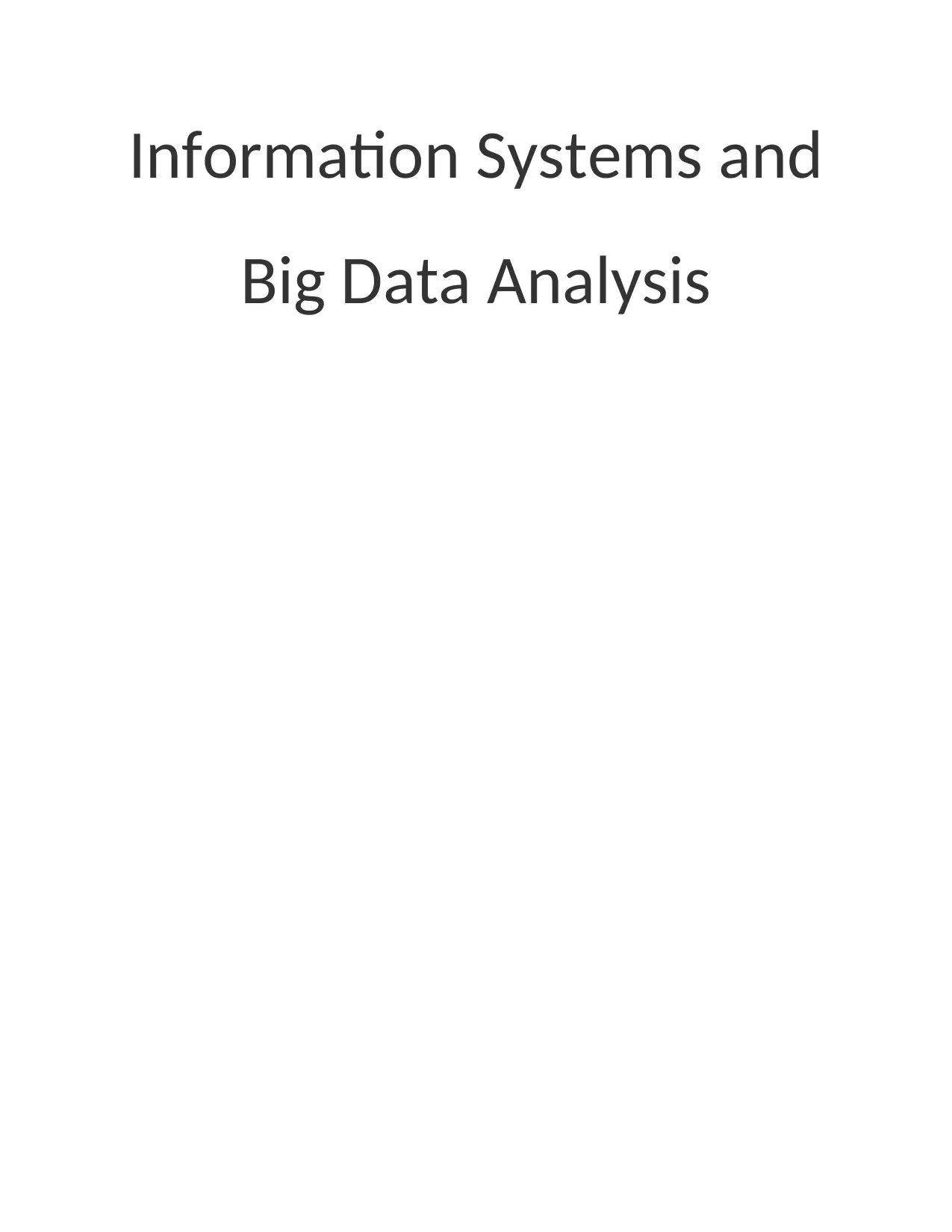
Information Systems and
Big Data Analysis
Big Data Analysis
Paraphrase This Document
Need a fresh take? Get an instant paraphrase of this document with our AI Paraphraser

Contents
Contents...........................................................................................................................................2
INTRODUCTION...........................................................................................................................1
MAIN BODY..................................................................................................................................1
TASK 1............................................................................................................................................1
Theories, models and techniques which related to the design and development of Information
Technology solutions:..................................................................................................................1
TASK 2............................................................................................................................................2
Explanation of different systems.................................................................................................2
TASK 3............................................................................................................................................4
Globalisation and its effect over IT on globalisation...................................................................4
TASK 4............................................................................................................................................5
Definition, examples, advantage and disadvantage of digital infrastructure...............................5
TASK 5............................................................................................................................................6
Risk associated with information system outsourcing and why is IT infrastructure so critical to
digital transformation...................................................................................................................6
CONCLUSION................................................................................................................................7
REFERENCES................................................................................................................................8
Contents...........................................................................................................................................2
INTRODUCTION...........................................................................................................................1
MAIN BODY..................................................................................................................................1
TASK 1............................................................................................................................................1
Theories, models and techniques which related to the design and development of Information
Technology solutions:..................................................................................................................1
TASK 2............................................................................................................................................2
Explanation of different systems.................................................................................................2
TASK 3............................................................................................................................................4
Globalisation and its effect over IT on globalisation...................................................................4
TASK 4............................................................................................................................................5
Definition, examples, advantage and disadvantage of digital infrastructure...............................5
TASK 5............................................................................................................................................6
Risk associated with information system outsourcing and why is IT infrastructure so critical to
digital transformation...................................................................................................................6
CONCLUSION................................................................................................................................7
REFERENCES................................................................................................................................8
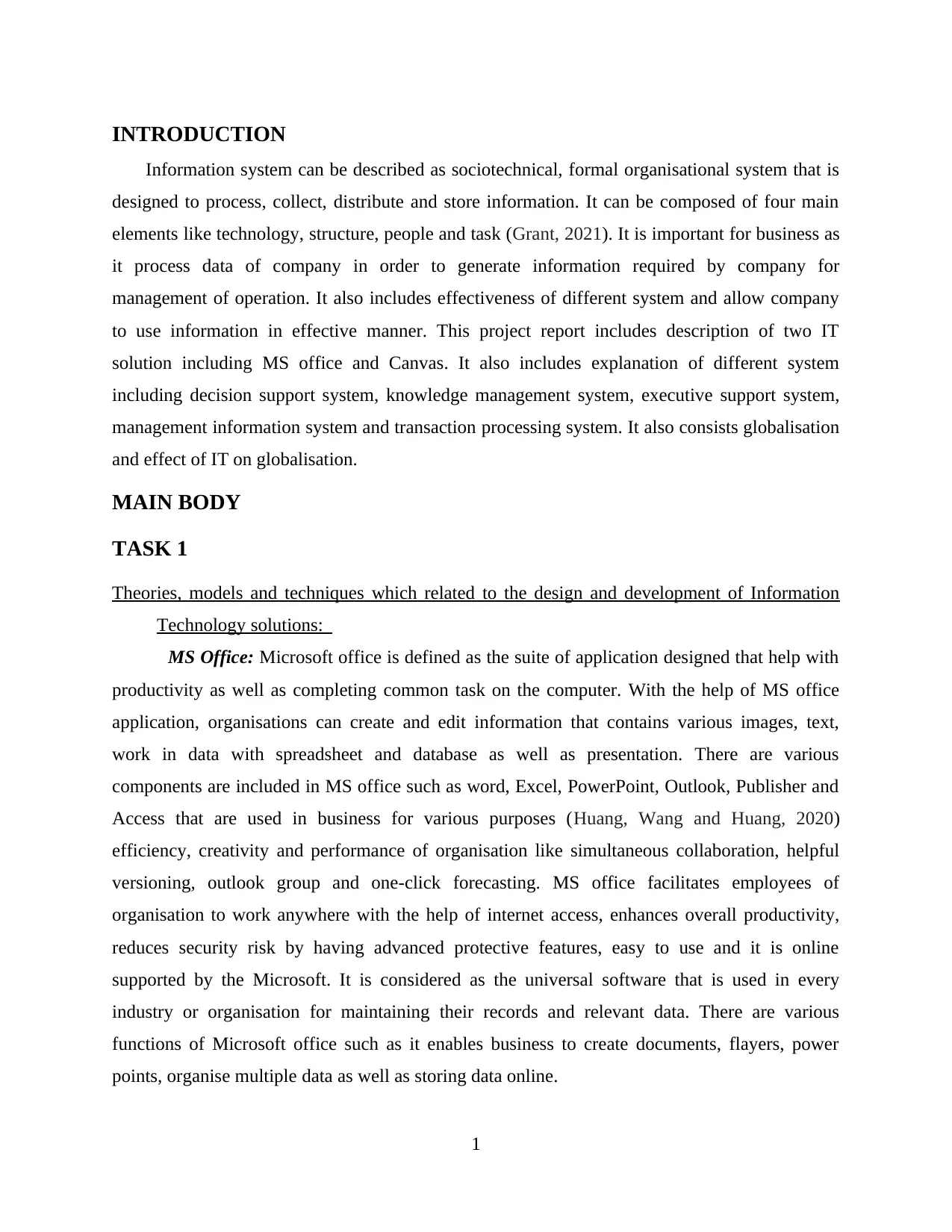
INTRODUCTION
Information system can be described as sociotechnical, formal organisational system that is
designed to process, collect, distribute and store information. It can be composed of four main
elements like technology, structure, people and task (Grant, 2021). It is important for business as
it process data of company in order to generate information required by company for
management of operation. It also includes effectiveness of different system and allow company
to use information in effective manner. This project report includes description of two IT
solution including MS office and Canvas. It also includes explanation of different system
including decision support system, knowledge management system, executive support system,
management information system and transaction processing system. It also consists globalisation
and effect of IT on globalisation.
MAIN BODY
TASK 1
Theories, models and techniques which related to the design and development of Information
Technology solutions:
MS Office: Microsoft office is defined as the suite of application designed that help with
productivity as well as completing common task on the computer. With the help of MS office
application, organisations can create and edit information that contains various images, text,
work in data with spreadsheet and database as well as presentation. There are various
components are included in MS office such as word, Excel, PowerPoint, Outlook, Publisher and
Access that are used in business for various purposes (Huang, Wang and Huang, 2020)
efficiency, creativity and performance of organisation like simultaneous collaboration, helpful
versioning, outlook group and one-click forecasting. MS office facilitates employees of
organisation to work anywhere with the help of internet access, enhances overall productivity,
reduces security risk by having advanced protective features, easy to use and it is online
supported by the Microsoft. It is considered as the universal software that is used in every
industry or organisation for maintaining their records and relevant data. There are various
functions of Microsoft office such as it enables business to create documents, flayers, power
points, organise multiple data as well as storing data online.
1
Information system can be described as sociotechnical, formal organisational system that is
designed to process, collect, distribute and store information. It can be composed of four main
elements like technology, structure, people and task (Grant, 2021). It is important for business as
it process data of company in order to generate information required by company for
management of operation. It also includes effectiveness of different system and allow company
to use information in effective manner. This project report includes description of two IT
solution including MS office and Canvas. It also includes explanation of different system
including decision support system, knowledge management system, executive support system,
management information system and transaction processing system. It also consists globalisation
and effect of IT on globalisation.
MAIN BODY
TASK 1
Theories, models and techniques which related to the design and development of Information
Technology solutions:
MS Office: Microsoft office is defined as the suite of application designed that help with
productivity as well as completing common task on the computer. With the help of MS office
application, organisations can create and edit information that contains various images, text,
work in data with spreadsheet and database as well as presentation. There are various
components are included in MS office such as word, Excel, PowerPoint, Outlook, Publisher and
Access that are used in business for various purposes (Huang, Wang and Huang, 2020)
efficiency, creativity and performance of organisation like simultaneous collaboration, helpful
versioning, outlook group and one-click forecasting. MS office facilitates employees of
organisation to work anywhere with the help of internet access, enhances overall productivity,
reduces security risk by having advanced protective features, easy to use and it is online
supported by the Microsoft. It is considered as the universal software that is used in every
industry or organisation for maintaining their records and relevant data. There are various
functions of Microsoft office such as it enables business to create documents, flayers, power
points, organise multiple data as well as storing data online.
1
⊘ This is a preview!⊘
Do you want full access?
Subscribe today to unlock all pages.

Trusted by 1+ million students worldwide
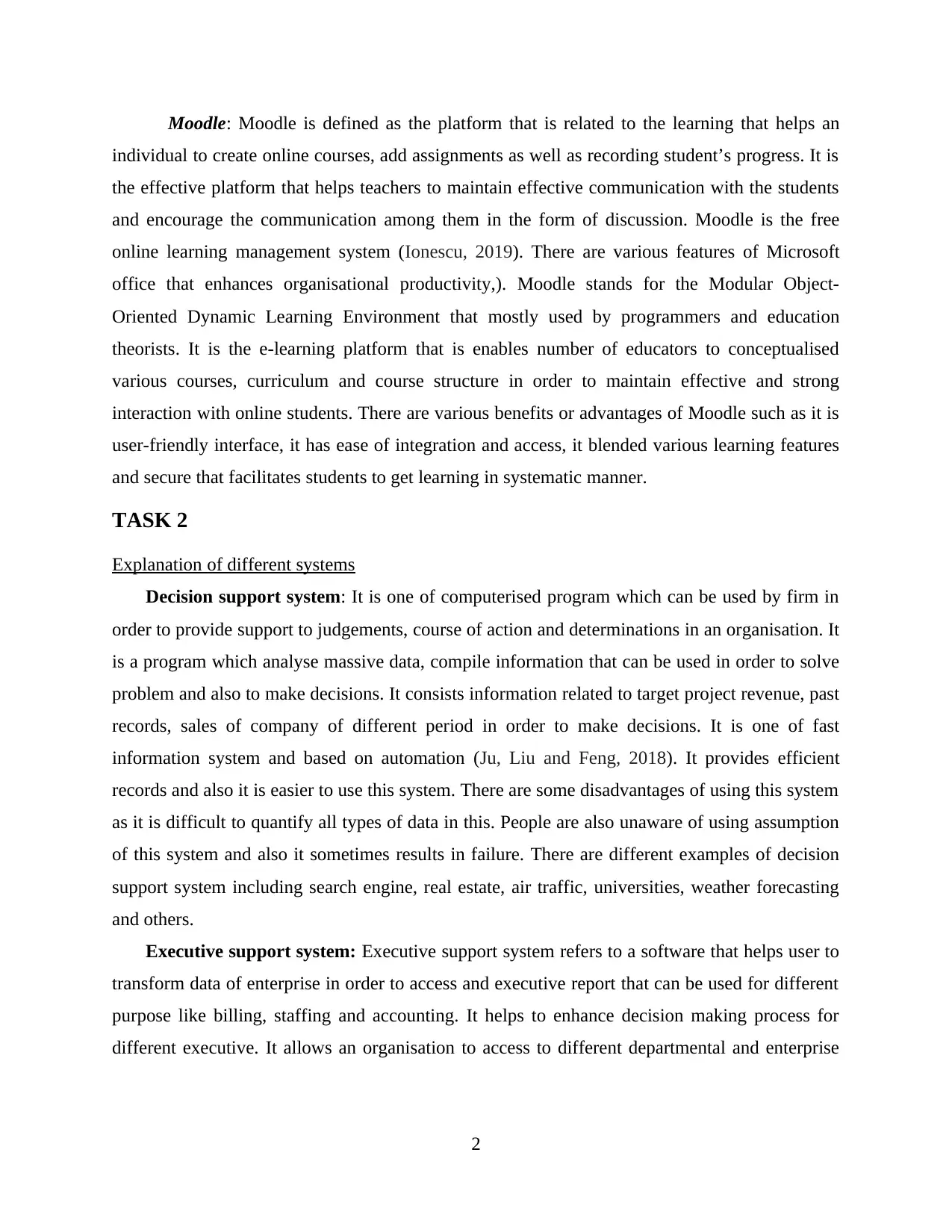
Moodle: Moodle is defined as the platform that is related to the learning that helps an
individual to create online courses, add assignments as well as recording student’s progress. It is
the effective platform that helps teachers to maintain effective communication with the students
and encourage the communication among them in the form of discussion. Moodle is the free
online learning management system (Ionescu, 2019). There are various features of Microsoft
office that enhances organisational productivity,). Moodle stands for the Modular Object-
Oriented Dynamic Learning Environment that mostly used by programmers and education
theorists. It is the e-learning platform that is enables number of educators to conceptualised
various courses, curriculum and course structure in order to maintain effective and strong
interaction with online students. There are various benefits or advantages of Moodle such as it is
user-friendly interface, it has ease of integration and access, it blended various learning features
and secure that facilitates students to get learning in systematic manner.
TASK 2
Explanation of different systems
Decision support system: It is one of computerised program which can be used by firm in
order to provide support to judgements, course of action and determinations in an organisation. It
is a program which analyse massive data, compile information that can be used in order to solve
problem and also to make decisions. It consists information related to target project revenue, past
records, sales of company of different period in order to make decisions. It is one of fast
information system and based on automation (Ju, Liu and Feng, 2018). It provides efficient
records and also it is easier to use this system. There are some disadvantages of using this system
as it is difficult to quantify all types of data in this. People are also unaware of using assumption
of this system and also it sometimes results in failure. There are different examples of decision
support system including search engine, real estate, air traffic, universities, weather forecasting
and others.
Executive support system: Executive support system refers to a software that helps user to
transform data of enterprise in order to access and executive report that can be used for different
purpose like billing, staffing and accounting. It helps to enhance decision making process for
different executive. It allows an organisation to access to different departmental and enterprise
2
individual to create online courses, add assignments as well as recording student’s progress. It is
the effective platform that helps teachers to maintain effective communication with the students
and encourage the communication among them in the form of discussion. Moodle is the free
online learning management system (Ionescu, 2019). There are various features of Microsoft
office that enhances organisational productivity,). Moodle stands for the Modular Object-
Oriented Dynamic Learning Environment that mostly used by programmers and education
theorists. It is the e-learning platform that is enables number of educators to conceptualised
various courses, curriculum and course structure in order to maintain effective and strong
interaction with online students. There are various benefits or advantages of Moodle such as it is
user-friendly interface, it has ease of integration and access, it blended various learning features
and secure that facilitates students to get learning in systematic manner.
TASK 2
Explanation of different systems
Decision support system: It is one of computerised program which can be used by firm in
order to provide support to judgements, course of action and determinations in an organisation. It
is a program which analyse massive data, compile information that can be used in order to solve
problem and also to make decisions. It consists information related to target project revenue, past
records, sales of company of different period in order to make decisions. It is one of fast
information system and based on automation (Ju, Liu and Feng, 2018). It provides efficient
records and also it is easier to use this system. There are some disadvantages of using this system
as it is difficult to quantify all types of data in this. People are also unaware of using assumption
of this system and also it sometimes results in failure. There are different examples of decision
support system including search engine, real estate, air traffic, universities, weather forecasting
and others.
Executive support system: Executive support system refers to a software that helps user to
transform data of enterprise in order to access and executive report that can be used for different
purpose like billing, staffing and accounting. It helps to enhance decision making process for
different executive. It allows an organisation to access to different departmental and enterprise
2
Paraphrase This Document
Need a fresh take? Get an instant paraphrase of this document with our AI Paraphraser

data through analysis and performance assessment. It is important in order to get important
outcomes and also apply statistical data in decision making process.
Transaction processing system: Transaction processing can be referring to a software that
helps to ensure completion of transaction of business and also track performance of business. It
is a system that can be used by e-commerce (Kunanets, Vasiuta and Boiko, 2019). It helps
business to complete transaction through storing, recurving and sending information. There are
different types of transaction processing system including batch processing, real time processing
and others. It is important for business as it provide various benefits like it increase transaction
speed, improve efficiency of cost, management of automation, improve reliability and other
things.
MIS (Management Information System): Management information system is defined as
an information system that is used by the organisation for decision-making as well as
maintaining coordination, controlling, analysing as well as visualising information in an
organisation in order to enhance overall business performance and efficiency. It is defined as the
computer system that consists hardware and software that perform as the backbone of an
organisation’s operations. In organisation MIS is used for gathering data from multiple online
system, access overall business information as well as report data to aid in management decision-
making. In business, it plays important role in gathering information, communication,
identification of problem as well as in business management, administration and operations that
leas business towards success and growth.
KSM (Knowledge Management System): Knowledge management system is defined as
the any kind of information technology system that helps business to store and retrieve
knowledge with the objective of improving understanding, collaborating as well as process
alignment. It is the system that apply and use the knowledge management principles that enables
organisational employees and customers to create, share and find most relevant information
quickly (Liang and Liu, 2018). KMS is considered as the tool that is used by the organisation to
organise documentation, questions that are asked to customers and other information that is
easily available for both internal and external customers. It carries out all organisational
functions in appropriate manner and follow best practices to deliver optimal results for the
organisation in effective and efficient manner.
3
outcomes and also apply statistical data in decision making process.
Transaction processing system: Transaction processing can be referring to a software that
helps to ensure completion of transaction of business and also track performance of business. It
is a system that can be used by e-commerce (Kunanets, Vasiuta and Boiko, 2019). It helps
business to complete transaction through storing, recurving and sending information. There are
different types of transaction processing system including batch processing, real time processing
and others. It is important for business as it provide various benefits like it increase transaction
speed, improve efficiency of cost, management of automation, improve reliability and other
things.
MIS (Management Information System): Management information system is defined as
an information system that is used by the organisation for decision-making as well as
maintaining coordination, controlling, analysing as well as visualising information in an
organisation in order to enhance overall business performance and efficiency. It is defined as the
computer system that consists hardware and software that perform as the backbone of an
organisation’s operations. In organisation MIS is used for gathering data from multiple online
system, access overall business information as well as report data to aid in management decision-
making. In business, it plays important role in gathering information, communication,
identification of problem as well as in business management, administration and operations that
leas business towards success and growth.
KSM (Knowledge Management System): Knowledge management system is defined as
the any kind of information technology system that helps business to store and retrieve
knowledge with the objective of improving understanding, collaborating as well as process
alignment. It is the system that apply and use the knowledge management principles that enables
organisational employees and customers to create, share and find most relevant information
quickly (Liang and Liu, 2018). KMS is considered as the tool that is used by the organisation to
organise documentation, questions that are asked to customers and other information that is
easily available for both internal and external customers. It carries out all organisational
functions in appropriate manner and follow best practices to deliver optimal results for the
organisation in effective and efficient manner.
3
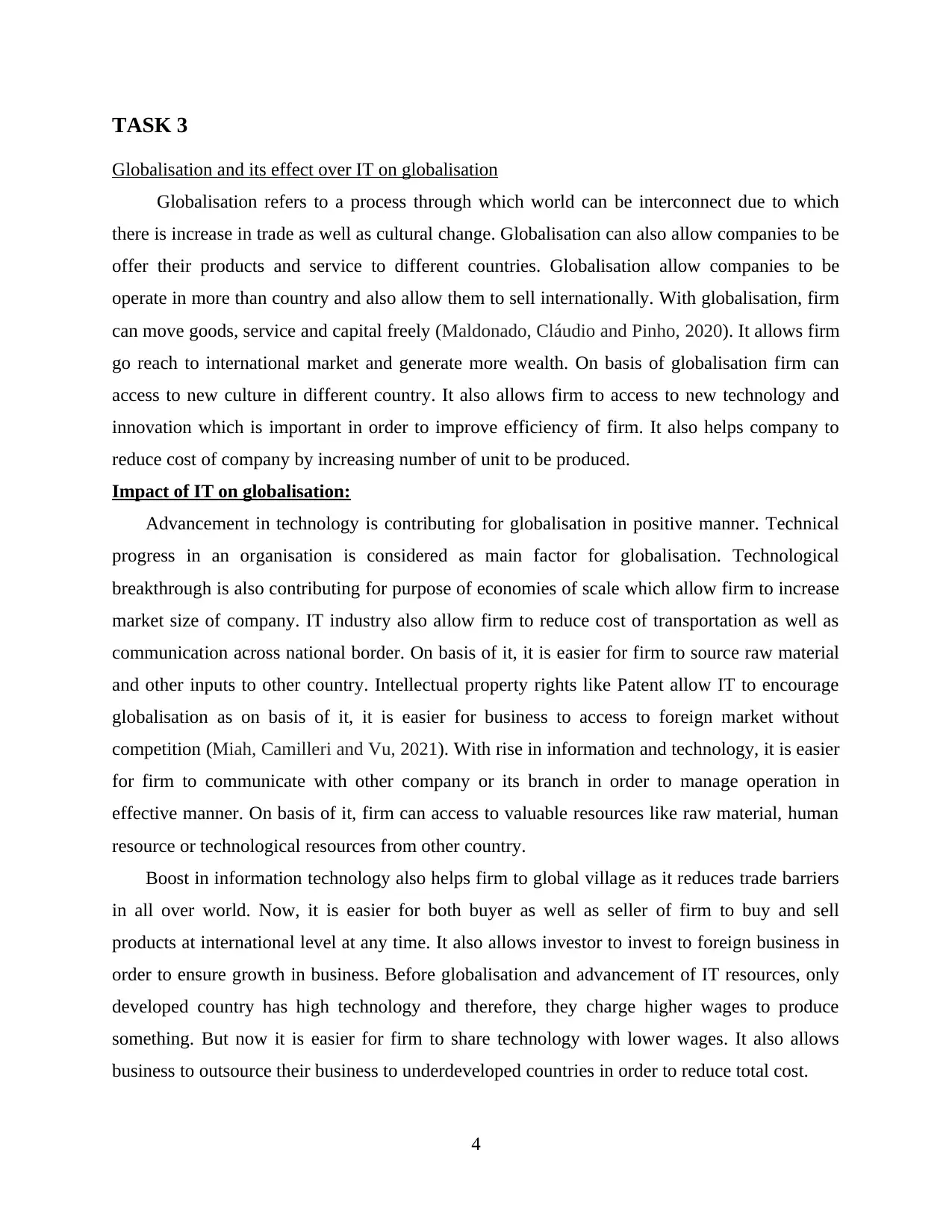
TASK 3
Globalisation and its effect over IT on globalisation
Globalisation refers to a process through which world can be interconnect due to which
there is increase in trade as well as cultural change. Globalisation can also allow companies to be
offer their products and service to different countries. Globalisation allow companies to be
operate in more than country and also allow them to sell internationally. With globalisation, firm
can move goods, service and capital freely (Maldonado, Cláudio and Pinho, 2020). It allows firm
go reach to international market and generate more wealth. On basis of globalisation firm can
access to new culture in different country. It also allows firm to access to new technology and
innovation which is important in order to improve efficiency of firm. It also helps company to
reduce cost of company by increasing number of unit to be produced.
Impact of IT on globalisation:
Advancement in technology is contributing for globalisation in positive manner. Technical
progress in an organisation is considered as main factor for globalisation. Technological
breakthrough is also contributing for purpose of economies of scale which allow firm to increase
market size of company. IT industry also allow firm to reduce cost of transportation as well as
communication across national border. On basis of it, it is easier for firm to source raw material
and other inputs to other country. Intellectual property rights like Patent allow IT to encourage
globalisation as on basis of it, it is easier for business to access to foreign market without
competition (Miah, Camilleri and Vu, 2021). With rise in information and technology, it is easier
for firm to communicate with other company or its branch in order to manage operation in
effective manner. On basis of it, firm can access to valuable resources like raw material, human
resource or technological resources from other country.
Boost in information technology also helps firm to global village as it reduces trade barriers
in all over world. Now, it is easier for both buyer as well as seller of firm to buy and sell
products at international level at any time. It also allows investor to invest to foreign business in
order to ensure growth in business. Before globalisation and advancement of IT resources, only
developed country has high technology and therefore, they charge higher wages to produce
something. But now it is easier for firm to share technology with lower wages. It also allows
business to outsource their business to underdeveloped countries in order to reduce total cost.
4
Globalisation and its effect over IT on globalisation
Globalisation refers to a process through which world can be interconnect due to which
there is increase in trade as well as cultural change. Globalisation can also allow companies to be
offer their products and service to different countries. Globalisation allow companies to be
operate in more than country and also allow them to sell internationally. With globalisation, firm
can move goods, service and capital freely (Maldonado, Cláudio and Pinho, 2020). It allows firm
go reach to international market and generate more wealth. On basis of globalisation firm can
access to new culture in different country. It also allows firm to access to new technology and
innovation which is important in order to improve efficiency of firm. It also helps company to
reduce cost of company by increasing number of unit to be produced.
Impact of IT on globalisation:
Advancement in technology is contributing for globalisation in positive manner. Technical
progress in an organisation is considered as main factor for globalisation. Technological
breakthrough is also contributing for purpose of economies of scale which allow firm to increase
market size of company. IT industry also allow firm to reduce cost of transportation as well as
communication across national border. On basis of it, it is easier for firm to source raw material
and other inputs to other country. Intellectual property rights like Patent allow IT to encourage
globalisation as on basis of it, it is easier for business to access to foreign market without
competition (Miah, Camilleri and Vu, 2021). With rise in information and technology, it is easier
for firm to communicate with other company or its branch in order to manage operation in
effective manner. On basis of it, firm can access to valuable resources like raw material, human
resource or technological resources from other country.
Boost in information technology also helps firm to global village as it reduces trade barriers
in all over world. Now, it is easier for both buyer as well as seller of firm to buy and sell
products at international level at any time. It also allows investor to invest to foreign business in
order to ensure growth in business. Before globalisation and advancement of IT resources, only
developed country has high technology and therefore, they charge higher wages to produce
something. But now it is easier for firm to share technology with lower wages. It also allows
business to outsource their business to underdeveloped countries in order to reduce total cost.
4
⊘ This is a preview!⊘
Do you want full access?
Subscribe today to unlock all pages.

Trusted by 1+ million students worldwide
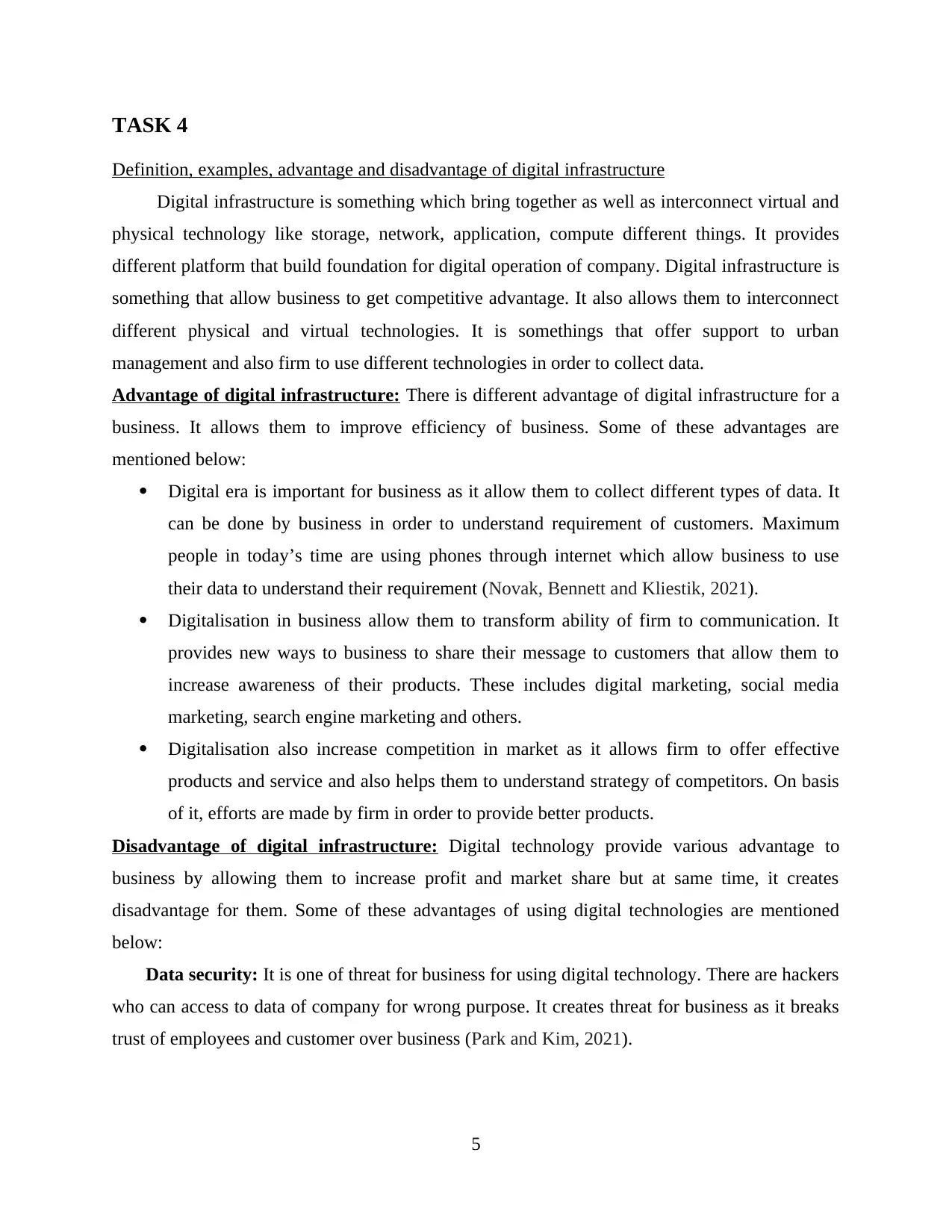
TASK 4
Definition, examples, advantage and disadvantage of digital infrastructure
Digital infrastructure is something which bring together as well as interconnect virtual and
physical technology like storage, network, application, compute different things. It provides
different platform that build foundation for digital operation of company. Digital infrastructure is
something that allow business to get competitive advantage. It also allows them to interconnect
different physical and virtual technologies. It is somethings that offer support to urban
management and also firm to use different technologies in order to collect data.
Advantage of digital infrastructure: There is different advantage of digital infrastructure for a
business. It allows them to improve efficiency of business. Some of these advantages are
mentioned below:
Digital era is important for business as it allow them to collect different types of data. It
can be done by business in order to understand requirement of customers. Maximum
people in today’s time are using phones through internet which allow business to use
their data to understand their requirement (Novak, Bennett and Kliestik, 2021).
Digitalisation in business allow them to transform ability of firm to communication. It
provides new ways to business to share their message to customers that allow them to
increase awareness of their products. These includes digital marketing, social media
marketing, search engine marketing and others.
Digitalisation also increase competition in market as it allows firm to offer effective
products and service and also helps them to understand strategy of competitors. On basis
of it, efforts are made by firm in order to provide better products.
Disadvantage of digital infrastructure: Digital technology provide various advantage to
business by allowing them to increase profit and market share but at same time, it creates
disadvantage for them. Some of these advantages of using digital technologies are mentioned
below:
Data security: It is one of threat for business for using digital technology. There are hackers
who can access to data of company for wrong purpose. It creates threat for business as it breaks
trust of employees and customer over business (Park and Kim, 2021).
5
Definition, examples, advantage and disadvantage of digital infrastructure
Digital infrastructure is something which bring together as well as interconnect virtual and
physical technology like storage, network, application, compute different things. It provides
different platform that build foundation for digital operation of company. Digital infrastructure is
something that allow business to get competitive advantage. It also allows them to interconnect
different physical and virtual technologies. It is somethings that offer support to urban
management and also firm to use different technologies in order to collect data.
Advantage of digital infrastructure: There is different advantage of digital infrastructure for a
business. It allows them to improve efficiency of business. Some of these advantages are
mentioned below:
Digital era is important for business as it allow them to collect different types of data. It
can be done by business in order to understand requirement of customers. Maximum
people in today’s time are using phones through internet which allow business to use
their data to understand their requirement (Novak, Bennett and Kliestik, 2021).
Digitalisation in business allow them to transform ability of firm to communication. It
provides new ways to business to share their message to customers that allow them to
increase awareness of their products. These includes digital marketing, social media
marketing, search engine marketing and others.
Digitalisation also increase competition in market as it allows firm to offer effective
products and service and also helps them to understand strategy of competitors. On basis
of it, efforts are made by firm in order to provide better products.
Disadvantage of digital infrastructure: Digital technology provide various advantage to
business by allowing them to increase profit and market share but at same time, it creates
disadvantage for them. Some of these advantages of using digital technologies are mentioned
below:
Data security: It is one of threat for business for using digital technology. There are hackers
who can access to data of company for wrong purpose. It creates threat for business as it breaks
trust of employees and customer over business (Park and Kim, 2021).
5
Paraphrase This Document
Need a fresh take? Get an instant paraphrase of this document with our AI Paraphraser
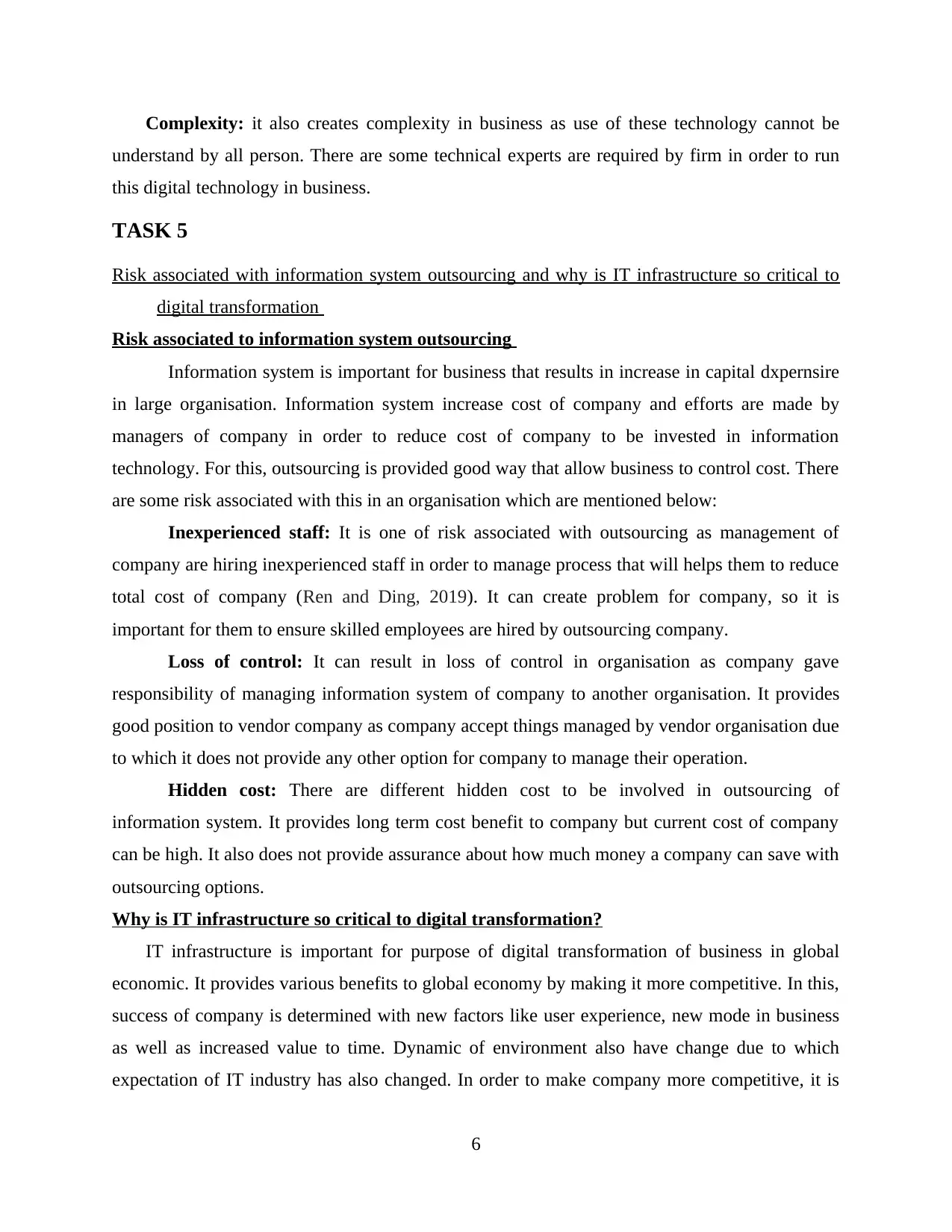
Complexity: it also creates complexity in business as use of these technology cannot be
understand by all person. There are some technical experts are required by firm in order to run
this digital technology in business.
TASK 5
Risk associated with information system outsourcing and why is IT infrastructure so critical to
digital transformation
Risk associated to information system outsourcing
Information system is important for business that results in increase in capital dxpernsire
in large organisation. Information system increase cost of company and efforts are made by
managers of company in order to reduce cost of company to be invested in information
technology. For this, outsourcing is provided good way that allow business to control cost. There
are some risk associated with this in an organisation which are mentioned below:
Inexperienced staff: It is one of risk associated with outsourcing as management of
company are hiring inexperienced staff in order to manage process that will helps them to reduce
total cost of company (Ren and Ding, 2019). It can create problem for company, so it is
important for them to ensure skilled employees are hired by outsourcing company.
Loss of control: It can result in loss of control in organisation as company gave
responsibility of managing information system of company to another organisation. It provides
good position to vendor company as company accept things managed by vendor organisation due
to which it does not provide any other option for company to manage their operation.
Hidden cost: There are different hidden cost to be involved in outsourcing of
information system. It provides long term cost benefit to company but current cost of company
can be high. It also does not provide assurance about how much money a company can save with
outsourcing options.
Why is IT infrastructure so critical to digital transformation?
IT infrastructure is important for purpose of digital transformation of business in global
economic. It provides various benefits to global economy by making it more competitive. In this,
success of company is determined with new factors like user experience, new mode in business
as well as increased value to time. Dynamic of environment also have change due to which
expectation of IT industry has also changed. In order to make company more competitive, it is
6
understand by all person. There are some technical experts are required by firm in order to run
this digital technology in business.
TASK 5
Risk associated with information system outsourcing and why is IT infrastructure so critical to
digital transformation
Risk associated to information system outsourcing
Information system is important for business that results in increase in capital dxpernsire
in large organisation. Information system increase cost of company and efforts are made by
managers of company in order to reduce cost of company to be invested in information
technology. For this, outsourcing is provided good way that allow business to control cost. There
are some risk associated with this in an organisation which are mentioned below:
Inexperienced staff: It is one of risk associated with outsourcing as management of
company are hiring inexperienced staff in order to manage process that will helps them to reduce
total cost of company (Ren and Ding, 2019). It can create problem for company, so it is
important for them to ensure skilled employees are hired by outsourcing company.
Loss of control: It can result in loss of control in organisation as company gave
responsibility of managing information system of company to another organisation. It provides
good position to vendor company as company accept things managed by vendor organisation due
to which it does not provide any other option for company to manage their operation.
Hidden cost: There are different hidden cost to be involved in outsourcing of
information system. It provides long term cost benefit to company but current cost of company
can be high. It also does not provide assurance about how much money a company can save with
outsourcing options.
Why is IT infrastructure so critical to digital transformation?
IT infrastructure is important for purpose of digital transformation of business in global
economic. It provides various benefits to global economy by making it more competitive. In this,
success of company is determined with new factors like user experience, new mode in business
as well as increased value to time. Dynamic of environment also have change due to which
expectation of IT industry has also changed. In order to make company more competitive, it is
6

important for company to adopt digital transformation. It allows business to fucus on agility and
also helps them to powering experience of user. It is also important for company to meet change
needs of business (Singh, 2019). It provides automation to company that is important in order to
improve internal capability of business that will also increase core competence of company. On
basis of these information and technology, business can be more upgrade and also digitally
transformed that allow them to accept changes occur in business and also to accept new trends in
market.
CONCLUSION
From above mentioned project report, it can be concluded that information system is one of
important component that allow business to manage their data and information in business in
effective manner. There are different techniques and different solution to be used in business like
MS office which allow a person to complete work of company in effective manner. There are
also different types of systems to be used by firm in order to make decision, manage information,
provide support to executives and also for managing information in effective manner.
Globalisation is also one of component that also contribute to advancement of IT. It allows
economy of different country to interconnect with each other. There are also different types of
risk associated by business with outsource as they outsource in order to reduce cost of company
and also to reduce burden over company.
7
also helps them to powering experience of user. It is also important for company to meet change
needs of business (Singh, 2019). It provides automation to company that is important in order to
improve internal capability of business that will also increase core competence of company. On
basis of these information and technology, business can be more upgrade and also digitally
transformed that allow them to accept changes occur in business and also to accept new trends in
market.
CONCLUSION
From above mentioned project report, it can be concluded that information system is one of
important component that allow business to manage their data and information in business in
effective manner. There are different techniques and different solution to be used in business like
MS office which allow a person to complete work of company in effective manner. There are
also different types of systems to be used by firm in order to make decision, manage information,
provide support to executives and also for managing information in effective manner.
Globalisation is also one of component that also contribute to advancement of IT. It allows
economy of different country to interconnect with each other. There are also different types of
risk associated by business with outsource as they outsource in order to reduce cost of company
and also to reduce burden over company.
7
⊘ This is a preview!⊘
Do you want full access?
Subscribe today to unlock all pages.

Trusted by 1+ million students worldwide
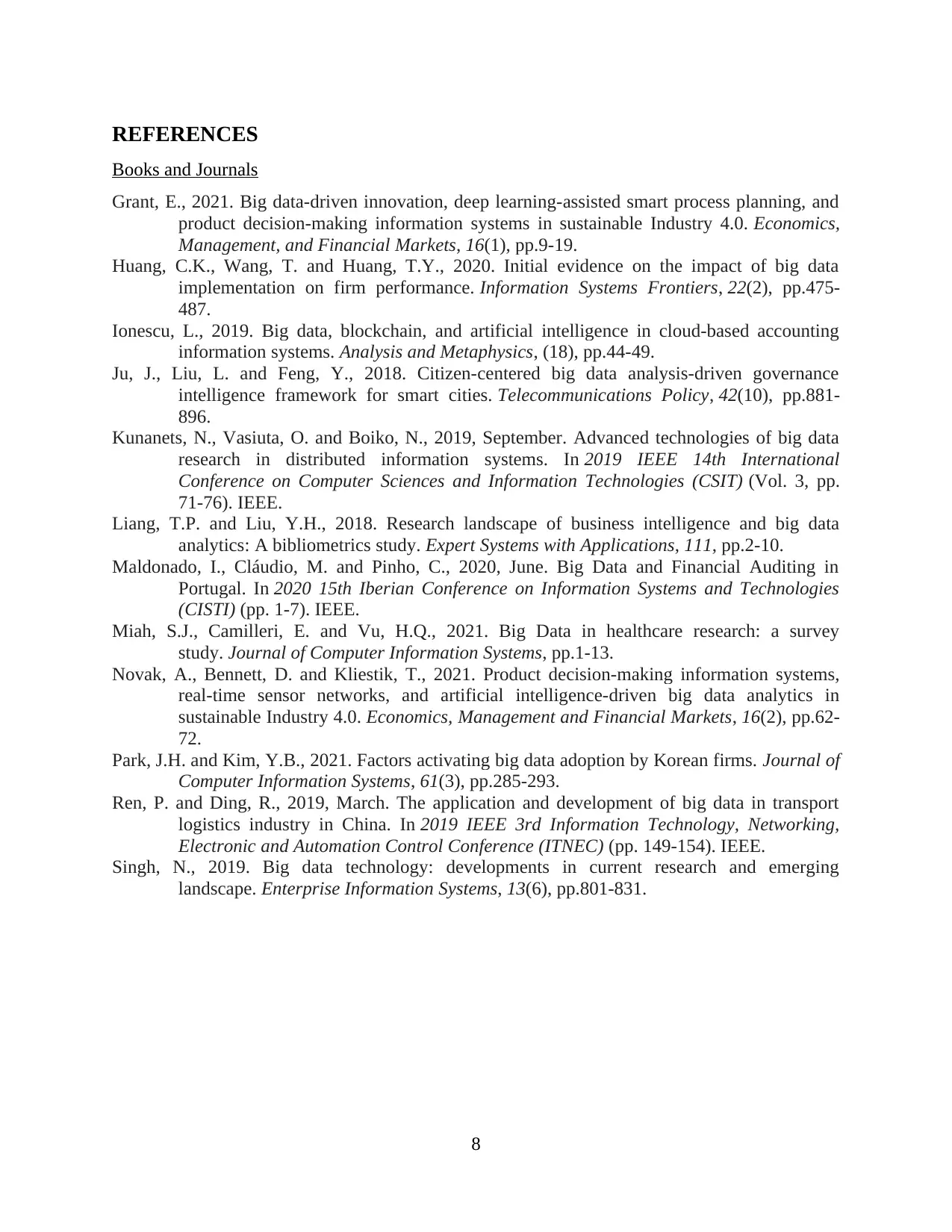
REFERENCES
Books and Journals
Grant, E., 2021. Big data-driven innovation, deep learning-assisted smart process planning, and
product decision-making information systems in sustainable Industry 4.0. Economics,
Management, and Financial Markets, 16(1), pp.9-19.
Huang, C.K., Wang, T. and Huang, T.Y., 2020. Initial evidence on the impact of big data
implementation on firm performance. Information Systems Frontiers, 22(2), pp.475-
487.
Ionescu, L., 2019. Big data, blockchain, and artificial intelligence in cloud-based accounting
information systems. Analysis and Metaphysics, (18), pp.44-49.
Ju, J., Liu, L. and Feng, Y., 2018. Citizen-centered big data analysis-driven governance
intelligence framework for smart cities. Telecommunications Policy, 42(10), pp.881-
896.
Kunanets, N., Vasiuta, O. and Boiko, N., 2019, September. Advanced technologies of big data
research in distributed information systems. In 2019 IEEE 14th International
Conference on Computer Sciences and Information Technologies (CSIT) (Vol. 3, pp.
71-76). IEEE.
Liang, T.P. and Liu, Y.H., 2018. Research landscape of business intelligence and big data
analytics: A bibliometrics study. Expert Systems with Applications, 111, pp.2-10.
Maldonado, I., Cláudio, M. and Pinho, C., 2020, June. Big Data and Financial Auditing in
Portugal. In 2020 15th Iberian Conference on Information Systems and Technologies
(CISTI) (pp. 1-7). IEEE.
Miah, S.J., Camilleri, E. and Vu, H.Q., 2021. Big Data in healthcare research: a survey
study. Journal of Computer Information Systems, pp.1-13.
Novak, A., Bennett, D. and Kliestik, T., 2021. Product decision-making information systems,
real-time sensor networks, and artificial intelligence-driven big data analytics in
sustainable Industry 4.0. Economics, Management and Financial Markets, 16(2), pp.62-
72.
Park, J.H. and Kim, Y.B., 2021. Factors activating big data adoption by Korean firms. Journal of
Computer Information Systems, 61(3), pp.285-293.
Ren, P. and Ding, R., 2019, March. The application and development of big data in transport
logistics industry in China. In 2019 IEEE 3rd Information Technology, Networking,
Electronic and Automation Control Conference (ITNEC) (pp. 149-154). IEEE.
Singh, N., 2019. Big data technology: developments in current research and emerging
landscape. Enterprise Information Systems, 13(6), pp.801-831.
8
Books and Journals
Grant, E., 2021. Big data-driven innovation, deep learning-assisted smart process planning, and
product decision-making information systems in sustainable Industry 4.0. Economics,
Management, and Financial Markets, 16(1), pp.9-19.
Huang, C.K., Wang, T. and Huang, T.Y., 2020. Initial evidence on the impact of big data
implementation on firm performance. Information Systems Frontiers, 22(2), pp.475-
487.
Ionescu, L., 2019. Big data, blockchain, and artificial intelligence in cloud-based accounting
information systems. Analysis and Metaphysics, (18), pp.44-49.
Ju, J., Liu, L. and Feng, Y., 2018. Citizen-centered big data analysis-driven governance
intelligence framework for smart cities. Telecommunications Policy, 42(10), pp.881-
896.
Kunanets, N., Vasiuta, O. and Boiko, N., 2019, September. Advanced technologies of big data
research in distributed information systems. In 2019 IEEE 14th International
Conference on Computer Sciences and Information Technologies (CSIT) (Vol. 3, pp.
71-76). IEEE.
Liang, T.P. and Liu, Y.H., 2018. Research landscape of business intelligence and big data
analytics: A bibliometrics study. Expert Systems with Applications, 111, pp.2-10.
Maldonado, I., Cláudio, M. and Pinho, C., 2020, June. Big Data and Financial Auditing in
Portugal. In 2020 15th Iberian Conference on Information Systems and Technologies
(CISTI) (pp. 1-7). IEEE.
Miah, S.J., Camilleri, E. and Vu, H.Q., 2021. Big Data in healthcare research: a survey
study. Journal of Computer Information Systems, pp.1-13.
Novak, A., Bennett, D. and Kliestik, T., 2021. Product decision-making information systems,
real-time sensor networks, and artificial intelligence-driven big data analytics in
sustainable Industry 4.0. Economics, Management and Financial Markets, 16(2), pp.62-
72.
Park, J.H. and Kim, Y.B., 2021. Factors activating big data adoption by Korean firms. Journal of
Computer Information Systems, 61(3), pp.285-293.
Ren, P. and Ding, R., 2019, March. The application and development of big data in transport
logistics industry in China. In 2019 IEEE 3rd Information Technology, Networking,
Electronic and Automation Control Conference (ITNEC) (pp. 149-154). IEEE.
Singh, N., 2019. Big data technology: developments in current research and emerging
landscape. Enterprise Information Systems, 13(6), pp.801-831.
8
1 out of 10
Related Documents
Your All-in-One AI-Powered Toolkit for Academic Success.
+13062052269
info@desklib.com
Available 24*7 on WhatsApp / Email
![[object Object]](/_next/static/media/star-bottom.7253800d.svg)
Unlock your academic potential
Copyright © 2020–2025 A2Z Services. All Rights Reserved. Developed and managed by ZUCOL.


